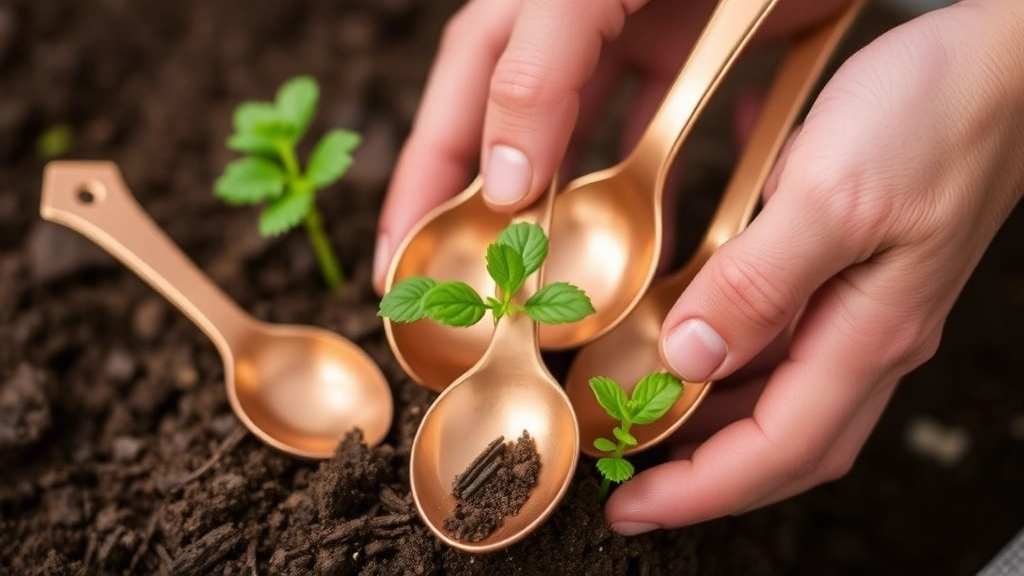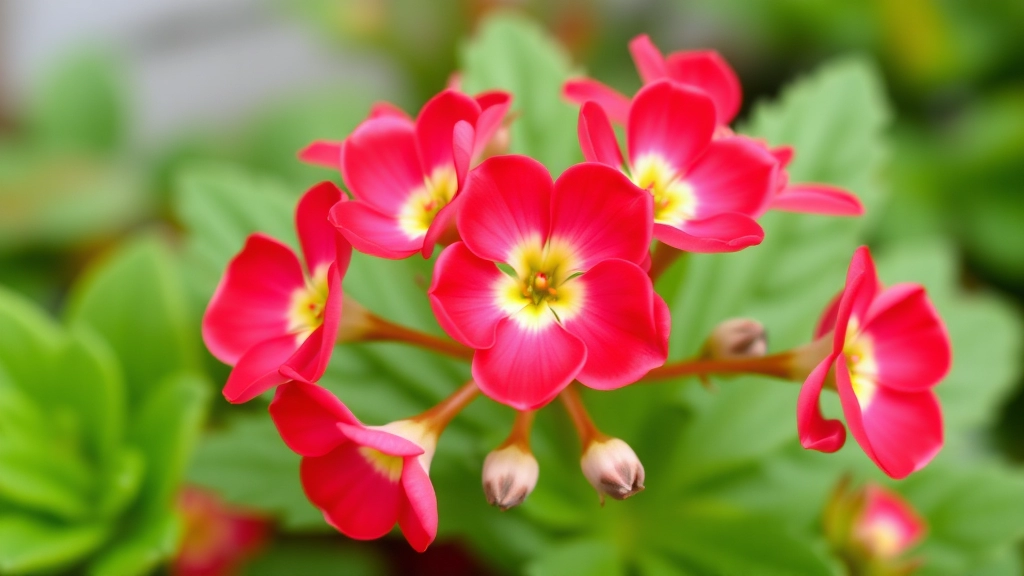Kalanchoe Copper Spoons Flower
The Kalanchoe Copper Spoons Flower, known scientifically as Kalanchoe orgyalis, is a captivating plant with its unique copper-toned leaves and occasional blooms. As a gardening enthusiast, you might be looking for the best ways to care for and propagate this intriguing succulent. Whether you’re interested in indoor or outdoor growth, understanding its specific needs will ensure your Copper Spoons thrive.
From optimal lighting conditions to soil and watering guidelines, this article will guide you through everything you need to know about growing and maintaining the Kalanchoe Copper Spoons Flower. We’ll also cover propagation techniques, pest management, and tips to encourage blooming, making your gardening experience both rewarding and successful.
Are you struggling to keep your Kalanchoe Orgyalis, commonly known as Copper Spoons, thriving? You’re not alone. Many plant enthusiasts face challenges in providing the right care for this unique succulent.
To ensure your Copper Spoons flourish, consider these essential care requirements:
## Light Exposure
– **Bright, Indirect Light:** Kalanchoe Orgyalis prefers bright, indirect sunlight. Too much direct sun can scorch its leaves, while insufficient light can hinder growth.
## Watering
– **Moderate Watering:** Water your Copper Spoons when the top inch of soil feels dry. Overwatering is a common mistake that can lead to root rot.
## Soil Type
– **Well-Draining Soil:** Use a cactus or succulent mix that allows excess water to escape. This helps prevent waterlogged roots.
## Temperature and Humidity
– **Temperature Range:** These plants thrive in temperatures between 18°C to 24°C. They can tolerate slightly cooler conditions but should be protected from frost.
– **Humidity Levels:** Kalanchoe Orgyalis prefers low to moderate humidity. Too much moisture in the air can lead to fungal diseases.
## Fertilization
– **Balanced Fertilizer:** During the growing season, feed your Copper Spoons with a balanced, diluted fertilizer every 4-6 weeks.
## Pest Management
– **Watch for Pests:** Common pests include mealybugs and aphids. Regularly inspect your plant and treat any infestations promptly.
For more detailed guidance on caring for various Kalanchoe species, you can refer to this [complete guide to growing and caring for pink Kalanchoe plants](https://planthq.org/complete-guide-to-growing-and-caring-for-pink-kalanchoe-plants/) and explore [top flowering Kalanchoe species and care tips](https://planthq.org/top-flowering-kalanchoe-species-and-care-tips/).
Optimal Lighting Conditions for Copper Spoons

So, you’ve got your Kalanchoe Orgyalis, also known as Copper Spoons, and now you’re wondering about the best lighting conditions to keep it thriving.
Let’s dive into the essentials!
Bright, Indirect Light is Key
Copper Spoons love bright light, but here’s the catch: avoid direct sunlight. Too much sun can scorch those lovely leaves.
- Ideal Spot: Place your plant near a south or west-facing window.
- Filtered Light: If direct sun is unavoidable, use sheer curtains to filter it.
Signs Your Plant is Happy
Ever wonder how to tell if your Copper Spoons are getting the right amount of light? Look for these signs:
- Vibrant Colour: Healthy, rich copper hues.
- Leaf Growth: New leaves popping up regularly.
- Stretching: If the plant starts to stretch towards the light, it might need a brighter spot.
What If It’s Too Dark?
If your Copper Spoons are in low light, they might become leggy and lose their vibrant colour.
- Move It: Try relocating it to a brighter area.
- Supplemental Lighting: Consider using grow lights if natural light is limited.
Seasonal Adjustments
As the seasons change, so does the light.
- Winter: You might need to move your plant closer to the window.
- Summer: Ensure it’s not getting too much harsh afternoon sun.
When it comes to growing Kalanchoe Orgyalis, also known as Copper Spoons, one of the most pressing concerns is selecting the right soil and potting conditions.
### What Soil Should You Use?
Copper Spoons thrive in well-draining soil. Here are some ideal options:
– **Cactus Mix:** A pre-made cactus or succulent mix is often perfect.
– **DIY Mix:** Combine potting soil with perlite or sand to enhance drainage.
– **pH Level:** Aim for a slightly acidic to neutral pH, around 6.0 to 7.0.
### Potting Tips
Choosing the right pot is just as crucial as the soil. Consider these points:
– **Drainage Holes:** Always opt for pots with drainage holes to prevent excess moisture.
– **Size Matters:** Start with a pot that’s slightly larger than the root ball. This allows for growth without overwhelming the plant.
– **Material:** Terracotta pots are excellent as they allow airflow and help wick away moisture.
### Repotting Frequency
Copper Spoons don’t need frequent repotting. Typically, every 2-3 years is sufficient unless you notice root crowding. For more details on how to ensure healthy growth, you can refer to the [essential care guide for Kalanchoe Chocolate Soldier](https://planthq.org/complete-care-guide-for-kalanchoe-chocolate-soldier/).
Additionally, if you’re interested in other Kalanchoe varieties, check out our [complete guide to growing Kalanchoe Mother of Thousands](https://planthq.org/complete-guide-to-growing-kalanchoe-mother-of-thousands/).
Watering Guidelines: How to Prevent Root Rot

One of the most common concerns for Kalanchoe Orgyalis, or Copper Spoons, is ensuring the right watering routine to avoid root rot.
Understanding Root Rot
Root rot occurs when the roots are consistently waterlogged, leading to decay. This can be a major issue for Copper Spoons, as they thrive in drier conditions.
Watering Tips:
- Check the Soil Moisture: Always assess the soil before watering. Stick your finger about an inch deep into the soil. If it feels dry, it’s time to water.
- Water Thoroughly: When you do water, ensure that you soak the soil evenly. This encourages deep root growth.
- Drainage is Key: Ensure your pot has drainage holes. This allows excess water to escape, preventing water accumulation.
- Frequency: During the growing season (spring and summer), water every two weeks. In winter, reduce this to once a month.
- Use Room Temperature Water: Cold water can shock the plant. Room temperature is ideal for Copper Spoons.
Signs of Overwatering:
- Yellowing leaves
- Wilting despite moist soil
- A foul smell from the soil
By following these guidelines, you can keep your Kalanchoe Orgyalis healthy and thriving.
Temperature and Humidity Needs
When caring for Kalanchoe Orgyalis, also known as Copper Spoons, understanding their temperature and humidity requirements is crucial for their health and vibrancy.
Ideal Temperature Range
Copper Spoons thrive in a warm environment. Here are the key temperature guidelines to keep in mind:
- Daytime Temperature: Aim for 20-24°C (68-75°F).
- Nighttime Temperature: A slight drop to 15-18°C (59-65°F) is ideal.
- Avoid Cold Drafts: Protect your plants from sudden temperature changes and cold drafts, as they can cause stress.
Humidity Preferences
Kalanchoe Orgyalis prefers a drier atmosphere, typical of its native habitat. Here’s what to consider:
VI. Fertilizing Copper Spoons for Vibrant Growth

So, you’ve got your Kalanchoe Orgyalis, also known as Copper Spoons, and you’re wondering how to keep it thriving.
One of the secrets to vibrant growth is proper fertilization.
When Should You Fertilize?
- Growing Season: Focus on spring and summer when your plant is actively growing.
- Frequency: Every 4-6 weeks is usually a sweet spot.
What Type of Fertilizer?
- Balanced Fertilizer: Look for a balanced, water-soluble fertilizer with equal parts nitrogen, phosphorus, and potassium (like a 20-20-20).
- Dilution: Always dilute it to half strength. This prevents over-fertilization, which can harm your plant.
How to Apply Fertilizer:
- Water First: Give your plant a good soak before applying fertilizer. This helps prevent root burn.
- Even Distribution: Pour the diluted solution evenly around the base of the plant.
- Avoid Leaves: Try not to get any on the leaves; it can cause burns.
Signs Your Plant Needs More or Less Fertilizer:
- Too Much: Yellowing leaves or a crusty build-up on the soil surface.
- Too Little: Slow growth or pale leaves.
Remember, every plant is unique. Pay attention to how your Copper Spoons respond and adjust accordingly.
How to Propagate Kalanchoe Orgyalis: Methods and Tips
If you’re looking to expand your collection of Kalanchoe Orgyalis, also known as Copper Spoons, you’re in for a treat. Propagation is straightforward and rewarding, allowing you to share these stunning plants with friends or fill your own space with their unique charm.
Propagation Methods
There are two primary methods for propagating Kalanchoe Orgyalis: leaf cuttings and offsets. Here’s how to do both:
Leaf Cuttings
- Select a Healthy Leaf: Choose a mature, healthy leaf from the parent plant.
- Cut the Leaf: Use a clean, sharp knife to cut the leaf at the base.
- Let it Callous: Place the leaf on a dry surface for a few days to allow the cut end to callous over. This step prevents rot when planted.
- Plant the Leaf: After the callousing period, place the leaf in well-draining soil, ensuring the cut end is buried.
- Water Sparingly: Lightly mist the soil but avoid overwatering.
Offsets
- Identify Offsets: Look for small offsets or pups growing at the base of the parent plant.
- Gently Remove: Carefully separate the offsets from the main plant, ensuring some roots are attached.
- Prepare the Soil: Plant the offsets in a well-draining potting mix.
- Water Lightly: Water sparingly until you see new growth.
Tips for Successful Propagation
- Timing Matters: Spring or early summer is the best time for propagation, as the plant is actively growing.
- Use Sterilised Tools: Always use sterilised tools to prevent disease.
- Humidity and Heat: Keep the cuttings in a warm, humid environment to encourage root growth.
By following these methods and tips, you’ll find that propagating Kalanchoe Orgyalis is not only easy but also immensely satisfying. For more detailed guidance on growing this plant, check out our Complete Guide to Growing Kalanchoe Copper Spoons Succulents. Additionally, if you’re interested in other Kalanchoe varieties, our Exploring Kalanchoe Beharensis Varieties article might be helpful.
Common Pests and How to Handle Them
So, you’ve got your Kalanchoe Orgyalis, and it’s thriving. But wait—what’s that? Pests lurking around?
Let’s chat about the common pests that can invade your Copper Spoons and how to tackle them before they become a real headache.
1. Mealybugs
- What They Look Like: Tiny, white, cotton-like clusters.
- How to Spot Them: Check the leaf joints and under the leaves.
- Treatment:
- Wipe them off with a cotton swab dipped in rubbing alcohol.
- Spray the plant with insecticidal soap if the infestation is severe.
2. Aphids
- What They Look Like: Small, green or black bugs.
- How to Spot Them: They usually gather on new growth.
- Treatment:
- Spray your plant with a strong jet of water to dislodge them.
- Introduce ladybugs to your garden; they love to munch on aphids.
3. Spider Mites
- What They Look Like: Tiny, red or yellow dots, often with fine webbing.
- How to Spot Them: Look for webbing, especially under the leaves.
- Treatment:
- Increase humidity around your plant.
- Spray with neem oil or insecticidal soap.
4. Scale Insects
- What They Look Like: Brown, raised bumps on leaves and stems.
- How to Spot Them: They can be hard to see but check for sticky residue (honeydew).
- Treatment:
- Remove them manually with a soft brush.
- Use horticultural oil to suffocate them.
Prevention Tips
- Regular Checks: Inspect your plants weekly for any signs of pests.
- Clean Leaves: Wipe down leaves to keep them dust-free and less appealing to bugs.
- Quarantine New Plants: Always keep new additions away from your existing plants for a couple of weeks.
How to Encourage Blooming in Copper Spoons
Are you wondering why your Kalanchoe Orgyalis, commonly known as Copper Spoons, isn’t blooming as expected?
Getting these stunning succulents to flower can be a delightful challenge.
Here are some effective strategies to encourage blooming in your Copper Spoons:
FAQs on Kalanchoe Orgyalis (Copper Spoons)
What are the optimal lighting conditions for Copper Spoons?
Copper Spoons thrive in bright, indirect light. Avoid direct sunlight as it can scorch the leaves. Place your plant near a south or west-facing window, and if direct sun is unavoidable, use sheer curtains to filter it.
How can I tell if my Copper Spoons are getting the right amount of light?
Look for vibrant copper hues and regular new leaf growth. If the plant starts to stretch towards the light, it might need a brighter spot.
What should I do if my Copper Spoons are in low light conditions?
Move the plant to a brighter area or consider using grow lights if natural light is limited.
How should I adjust lighting for Copper Spoons during different seasons?
In winter, you might need to move your plant closer to the window. In summer, ensure it’s not getting too much harsh afternoon sun.
What are the watering guidelines for Copper Spoons?
Water thoroughly when the soil feels dry about an inch deep. Ensure proper drainage to prevent root rot. During the growing season, water every two weeks; in winter, reduce to once a month.
How can I prevent root rot in Copper Spoons?
Ensure the pot has drainage holes, avoid overwatering, and use room temperature water. Check the soil moisture before watering.
What are the signs of overwatering Copper Spoons?
Yellowing leaves, wilting despite moist soil, and a foul smell from the soil are common signs of overwatering.
When and how should I fertilize Copper Spoons?
Fertilize every 4-6 weeks during the growing season (spring and summer) using a balanced, water-soluble fertilizer diluted to half strength. Water the plant first before applying the fertilizer.
What are the signs that my Copper Spoons need more or less fertilizer?
Too much fertilizer can cause yellowing leaves or a crusty build-up on the soil surface. Too little fertilizer can result in slow growth or pale leaves.
What are common pests that affect Copper Spoons and how can I handle them?
Mealybugs
They appear as tiny, white, cotton-like clusters. Check leaf joints and under the leaves. Wipe them off with a cotton swab dipped in rubbing alcohol or spray with insecticidal soap for severe infestations.
Aphids
These are small, green or black bugs that gather on new growth. Spray your plant with a strong jet of water or introduce ladybugs to your garden to control them.
Spider Mites
Look for tiny, red or yellow dots and fine webbing, especially under the leaves. Increase humidity around your plant and spray with neem oil or insecticidal soap.
Scale Insects
They appear as brown, raised bumps on leaves and stems. Check for sticky residue (honeydew). Remove them manually with a soft brush or use horticultural oil to suffocate them.
Prevention Tips
- Inspect your plants weekly for any signs of pests.
- Wipe down leaves to keep them dust-free and less appealing to bugs.
- Quarantine new plants away from existing ones for a couple of weeks.
References
-
How to Grow and Care for Kalanchoe Orgyalis (Copper Spoons)
-
Copper Spoons Plant Care
-
Kalanchoe Orgyalis (Copper Spoons) Plant Care Guide
